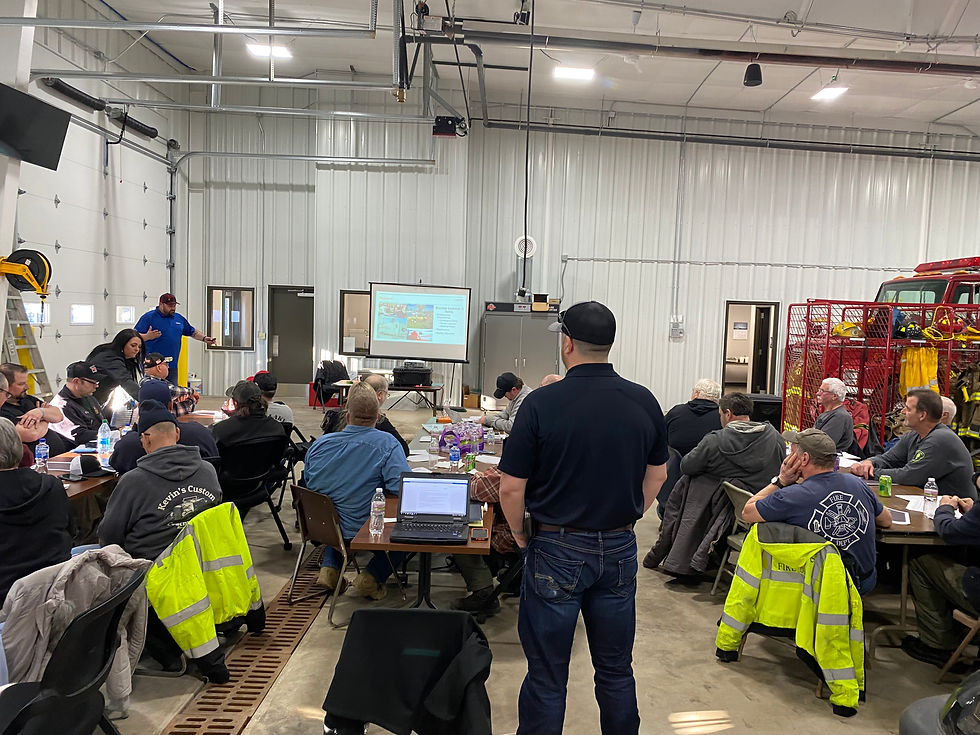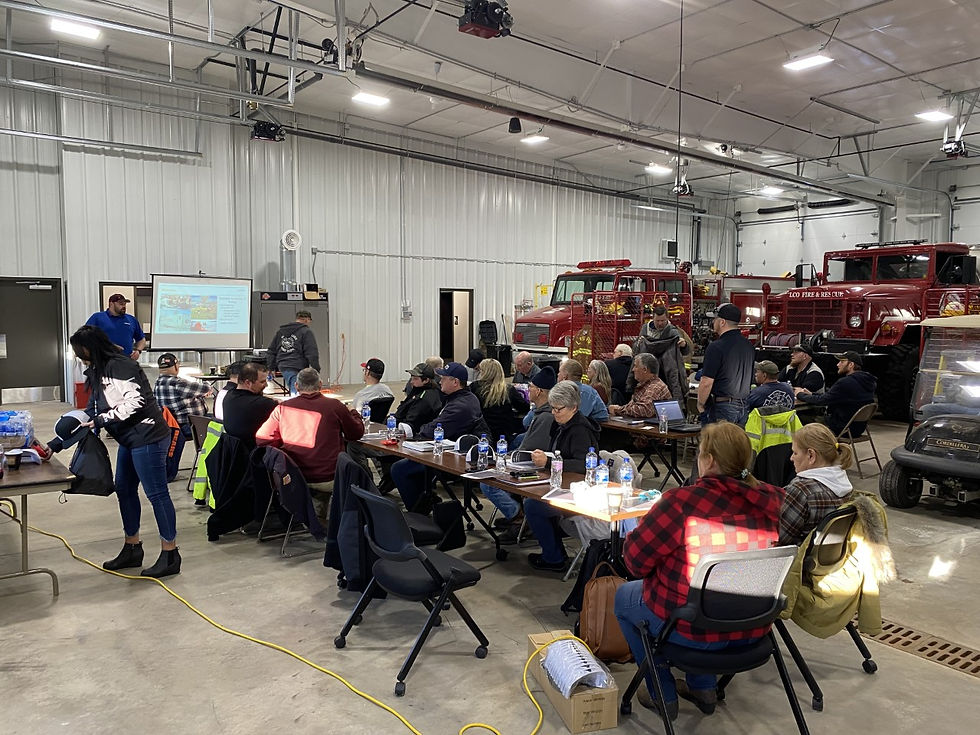Enbridge and Local Public Safety Agencies Hold Disaster Scenario Tabletop Exercise
- joemorey
- Mar 22, 2023
- 4 min read
By Joe Morey
News Editor

A tabletop exercise was held between area fire and police personnel and Enbridge Energy Partners executives to train on how to handle a potential emergency.
The scope of the tabletop exercise discussed the Emergency Response capabilities of Enbridge, local first response agencies and community stakeholders in relation to a release of crude oil from the pipeline.
Area fire departments that participated in the exercise included LCO, Bass Lake, Couderay, Stone Lake, Winter, Town and City of Hayward. Other participants included the LCO Police, Hayward Police, Sawyer County Sheriff’s Department, Sawyer County Hazmat, and the Public Health Officer.
Gary Kneisl is the Emergency Response Specialist, Enbridge Midwest Region, and was the exercise point of contact for Enbridge. Other Enbridge officials were also on hand for any questions.
The scenario of the exercise was that at approximately 6:00 pm, a train traveling eastbound on the tracks near the Enbridge Edgewater Station and Summit Creek derailed and slid across the Enbridge Right of Way (ROW) at a high rate of speed. The train made a deep gouge in the earth as it moved and came to rest with the lead engine in Summit Creek. The deep trench left in the ground is directly over the Enbridge ROW and has damaged the crossing at West Right of Way Road.
A local citizen driving along W Right of Way Road comes across the incident and called 911 to report it. Other drivers stop and additional calls come in describing a large amount of smoke and a strong petrochemical odor in the air.
911 dispatches local fire departments and law enforcement.
The Enbridge CCO notices a pressure drop on Line 6A and shuts the line down and notifies Enbridge manager on call. The manger dispatches a technician to the location and notifies 911.
Shortly, local first responders begin to arrive and report that there is a dark liquid covering the ground and in the Summit Creek. They also note that the tank cars are largely black tank cars. It is unknown if the black liquid is from the train or Enbridge line.
At this point in the exercise, Kiesl begins to go over a series of questions on what actions the local fire and police personnel would or would not begin to take.
First things the sheriff’s department would do include setting up the Emergency Operations Command (EOC).
Kiesl explained Enbridge would at this time contact the Environmental Protection Agency (EPA), call himself and also contact the railroad company.
“We have the equipment to respond and minimize the effect on the environment and the safety of the people,” Kiesl said. “We like to handle the containment. Sometimes there may be more problems and bigger than it was originally thought.”
He was referring to the capabilities of Enbridge to handle such situations, which they are better prepared than other agencies and they have specialized equipment.
He said the EPA is the on-call federal regulator and although Wisconsin is the only state where the DNR could take control, you’d want the EPA because that’s the only way you may access federal money. In this particular exercise, Kiesl said the railroad would most likely be at fault and would be on the hook for the money.
“If Enbridge were responsible, then we are going to start writing the checks,” Kiesl said.
The site of the disaster scenario was on the Reservation so Kiesl said it would be between LCO, DNR and the EPA. He said you’d want a unified command structure so that the funding resources are there. Smaller disaster situations may not need federal regulators, but in this scenario, the feds would be appropriate.
Kiesl went on to share what the Enbridge model is for the first steps to take with this scenario. It’s called SIN;
1. Safety of responders and bystanders
2. Isolate energy sources and ignition sources
3. Notify everyone we can that can help
The exercise further discussed actions the fire departments and the police would take, such as fire securing the scene and doing reconnaissance. They’d also help go door to door to alert residents and ask them to evacuate if there were hazardous chemicals on board the train. In Wisconsin, there is no mandatory evacuation.
While Enbridge is in isolation mode, they are also staging crews and they’d also be investigating whether it was more than crude oil that spilt in the scenario.
Kiesl said if crude oil was in Summit Creek they’d also send teams down the river to stop the flow.
Tony Price, LCO’s emergency management coordinator, said residents who are asked to evacuate would be able to go to any LCO shelters, which are currently in place because of the winter weather recently experienced.
Sawyer County Public Health would also be a part of the evacuation process.
Due to the poor signal in the area of the scenario, Enbridge also said they would be able to establish satellite internet. It was also mentioned that the Wisconsin State Patrol has a mobile tower on an airplane that could possibly be used in this scenario too. The plane is like having a tower right over the situation.
The disaster response exercise went on to cover the clean up process, resources needed, what agencies would continue to be involved, additional actions needed, whether the local citizens and community have the infrastructure in place, such as water, food, lodging, medications, etc.









Click here provide members with discounts on over-the-counter medications, vitamins, and health essentials, promoting better health management and cost-effective wellness solutions. kaiserotcbenefits.com - more details here
Click here help you find recent death notices, providing information about funeral services, memorials, and tributes for loved ones in your area. obituariesnearme.com - more details here
Click here? Many users have had mixed experiences with the platform, so it's important to read reviews and verify deals before booking. istravelurolegit.com - more details here
AV在线看 AV在线看;
自拍流出 自拍流出;
国产视频 国产视频;
日本无码 日本无码;
动漫肉番 动漫肉番;
吃瓜专区 吃瓜专区;
SM调教 SM调教;
ASMR ASMR;
国产探花 国产探花;
强奸乱伦 强奸乱伦;
AV在线看 AV在线看;
自拍流出 自拍流出;
国产视频 国产视频;
日本无码 日本无码;
动漫肉番 动漫肉番;
吃瓜专区 吃瓜专区;
SM调教 SM调教;
ASMR ASMR;
国产探花 国产探花;
强奸乱伦 强奸乱伦;
AV在线看 AV在线看;
自拍流出 自拍流出;
国产视频 国产视频;
日本无码 日本无码;
动漫肉番 动漫肉番;
吃瓜专区 吃瓜专区;
SM调教 SM调教;
ASMR ASMR;
国产探花 国产探花;
强奸乱伦 强奸乱伦;
代发外链 提权重点击找我;
蜘蛛池 蜘蛛池;
谷歌马甲包/ 谷歌马甲包;
谷歌霸屏 谷歌霸屏;
谷歌霸屏 谷歌霸屏
蜘蛛池 蜘蛛池
谷歌快排 谷歌快排
Google外链 Google外链
谷歌留痕 谷歌留痕
Gái Gọi…
Gái Gọi…
Dịch Vụ…
谷歌霸屏 谷歌霸屏
负面删除 负面删除
币圈推广 币圈推广
Google权重提升 Google权重提升
Google外链 Google外链
google留痕 google留痕